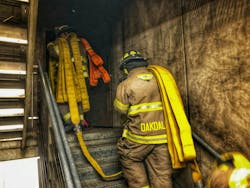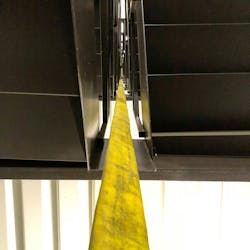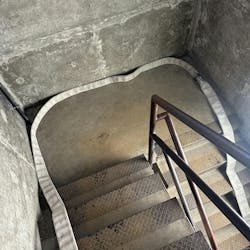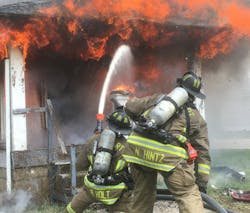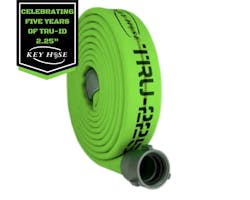Engine Essentials: Navigating Stairs
It’s common to have fires in occupancies that require handlines to be stretched and/or advanced up or down stairs. Engine company members must be well versed in various techniques when dealing with stairs to ensure the attack is successful. The hose must be stretched to the entry point in an efficient manner to avoid kinks and prevent members from having to go back to fix errors. Extra hose must be staged in such a way that it can be quickly moved in a coordinated manner for fire attack.
Types of stairs
There are many types of stairways and stair construction. The two main types of stairs that this column focuses on are the protected stairwell and unprotected staircase.
Protected stairwells are often found in newer multifamily dwellings and commercial occupancies. Protected stairwells are isolated using self-closing fire doors that are designed to keep smoke and/or fire conditions out of the stairwell.
Unprotected staircases are common in single-family dwellings and older multifamily dwellings. Unprotected staircases aren’t isolated by fire doors. Some staircases may have a wooden or hollow-core door leading to them, as often found leading to the basement, that might prevent some smoke travel and temporarily slow fire spread.
Size-up
Building construction, occupancy type, size of the structure, type of stairs, and the fire location and extent help determine whether the handline can be stretched dry to a remote location or whether it must be charged and advanced (see “Stretching vs. Advancing” on page 17). Engine company officers must rapidly assess factors impacting fire attack and communicate to their members where they want the hoseline stretched. This may involve the officer having to quickly look inside the building to evaluate conditions as well as stair type. In larger structures, a reconnaissance company might be necessary to determine where the hoseline should be placed while the engine company stands fast at the apparatus ready to stretch.
The occupancy and building construction type helps determine construction features and systems that may have a direct impact on suppression operations. For example, a
newer multistory, multifamily dwelling typically has protected stairwells and standpipe systems. Location of the fire, smoke and fire conditions and systems in the stairwell will be
deciding factors as to the viability of using the standpipe as opposed to hand stretching from the engine.
The size of the building has a direct bearing on the amount of hose needed to reach and extinguish the fire. The larger the building, the more important it becomes to do a thorough size-up to determine the best entry point that is closest to the fire. If necessary, the apparatus can be moved closer to the selected attack stairwell. This provides the fastest
reflex time to get a handline into operation as well as a close egress point to ensure companies operating on air can safely exit the structure.
The location and extent of the fire are the main determining factors if a hoseline can be stretched dry. In many cases, the attack line can be stretched right to the door of the fire occupancy. However, conditions in the stairwells and hallways must be evaluated. Protected and unprotected stairs can fill with smoke, necessitating the hoseline to be charged on a lower floor and advanced upward.
If there’s smoke in the stairs, hoselines may be able to be stretched to a lower floor if conditions allow. This is especially true in larger dwellings with fire on the upper floor. It’s critical that the exact location of the fire is determined and the lower floors checked, to ensure there’s no fire below the members operating without a charged hoseline in place. If the fire is located in the basement or lower floor, the line must be charged prior to entering the occupancy or stairwell.
Stretching guidance
It’s critical that the stretch be properly estimated prior to beginning. The company officer must consider the following distances: apparatus to entry point, entry point to selected attack stairs, number of floors to the fire floor, attack stairs to the fire occupancy, and amount needed to reach and cover the fire area. The total number of lengths should be communicated to the engine company members. If necessary, two engine companies should be married up to facilitate an especially long or difficult stretch.
The required hose should be loaded onto the firefighters in a manner that allows it to pay off efficiently. The goal should be to lay hose to the target objective versus dragging it around every pinch point. The other advantage this provides is it allows it to be placed in positions that are tactically advantageous.
As the hose is stretched up/down stairs, it should be placed to the outside of the stairs. This provides three benefits. First, it keeps the stairs clear for firefighter ingress and occupant egress. Second, it prevents the line from kinking around railings and sharp corners when charged. Third, it provides some extra hose if the stretch/advance comes up slightly short.
Members should police the stretch as they go to ensure the hoseline is being placed to the outside, there are no kinks, all extra hose is flaked out and any doors the line goes through are chocked in the open position. Prior to calling for water, a final check should be performed to confirm there are no issues that could delay the operation or cause a safety concern.
Advancing considerations
Just as discussed in the stretching recommendations section above, company officers must ensure enough hose is available to reach the objective. This can be a little more challenging, as the visual indication of the hoseline physically traveling through the building isn’t available. The hoseline is stretched to and then charged in a remote location, such as outside, prior to advancement into the hazard area. With enough training and experience, officers can develop confidence in their estimates.
The hoseline should be charged in a safe area/atmosphere. Once charged, the line is advanced to the fire area for extinguishment. To make this more efficient when dealing with a fire located up/down stairs, the nozzle team can bring the nozzle and 50-foot coupling to the start of the stairs or all the way to the top/bottom of the stairs. This provides 50 feet of hose immediately available for advancement to the fire area, minimizes time spent in the narrow confines of the stairs and eliminates pinch points at the entry to the stairs.
Alternative options
Another component of stair construction that should be assessed is the presence of a well-hole. A well-hole is the space between the stair treads and railings. A well-hole becomes a viable option for stretching lines if its width exceeds the diameter of the hoseline. A quick way to check whether a well-hole is usable: A 2½-inch line will fit through a well that’s roughly the size of a gloved fist.
By utilizing the well-hole, a single 50-foot length of hose can be stretched vertically and reach roughly the fifth floor. This is significantly more efficient than a traditional stretch, as the same stretch to the fifth floor would require four sections of hose. Using the well-hole also has the advantage of keeping the stair treads clear for ingress and egress as well as eliminating numerous pinch points.
Several methods are available to accomplish a well-hole stretch. All techniques involve bringing to the base of the stairs the hose necessary to cover the vertical height of the well and reach the fire area.
The first technique involves grabbing the nozzle and climbing the stairs while keeping the hose in the well. As firefighters climb, the hose at the base of the stairs advances up the well-hole. Often, the hose is brought to the floor or half landing below the fire to prevent a hard kink/bend as the hose goes over the railing. Once at the selected floor or landing, the remaining hose is pulled up, stretched to the objective and flaked out. Prior to charging, the hoseline is secured to the railing using a short piece of rope or webbing.
The second technique involves climbing the stairs with the hose necessary to reach from the top of the well-hole to the fire area. This technique eliminates having to pull hose up the well-hole. It’s vital that firefighters keep the necessary lengths securely on their shoulders to ensure it’s available to reach the fire. Again, the hose is stretched to the objective, flaked out and secured to the railing prior to charging.
The final technique for accomplishing a well-hole stretch is a rope stretch. This isn’t the best option for narrow well-holes as the rope being dropped or the nozzle/couplings being pulled up can become hung up on a lower floor. Rope stretches work best in wide well-holes. The rope is dropped and secured to the nozzle for hoisting. The hose is then pulled up, stretched to the objective, flaked out and secured to the railing as with the other methods.
Proficiency
It’s vital that engine companies train on stretching and advancing hoselines up and down stairs. Engine companies must get into the various buildings in their district to gain a thorough knowledge of the challenges they will face. Through practice, proficiency in the necessary techniques can be gained to ensure the safest and most efficient fire attack possible.
Product Spotlight
Fog Nozzle
The Elkhart Brass Chief XD fixed-flow fog nozzle is an absolute workhorse. Available in a variety of flow rates and pressures down to 50 psi (3.5 BAR), the Chief XD features a forged metal bale handle, custom etching and a variety of bumper colors.
2¼-inch Hose
TRU-ID 2¼-inch from Key Hose is designed for maximum flow and superior handling. Its true internal diameter ensures optimal water delivery while remaining lightweight and flexible. Ideal for aggressive interior attacks, TRU-ID enhances firefighter performance with excellent maneuverability and reliability.
Stretching vs. Advancing
STRETCHING involves taking a dry hoseline to a potentially remote entry point with clear conditions or behind the protection of a closed door, prior to the line being charged. This allows the line to be placed quicker and often with fewer personnel because of the lack of water weight and rigidity. The working length, or the amount of hose necessary to make the fire area, can be brought and flaked out for easy advancement.
ADVANCING a handline involves maneuvering a charged hoseline into position to attack the fire. Because of conditions or best practice based on the occupancy or location of the fire, the hose must be charged prior to entry or at a safe location. This is often the case in single-family dwellings where the attack line is charged exterior at the selected entry point.
About the Author
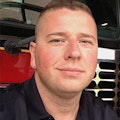
Jonathan Hall
Jonathan Hall, who is a Firehouse contributing editor, has more than 24 years of fire service experience. He currently is a captain with the St. Paul, MN, Fire Department assigned to Engine Company 14. Hall also serves as a lead instructor in the department's Training Division; he teaches hands-on skills to members of all ranks. Hall is the co-owner of Make The Move Training LLC and teaches engine company operations throughout the country.
